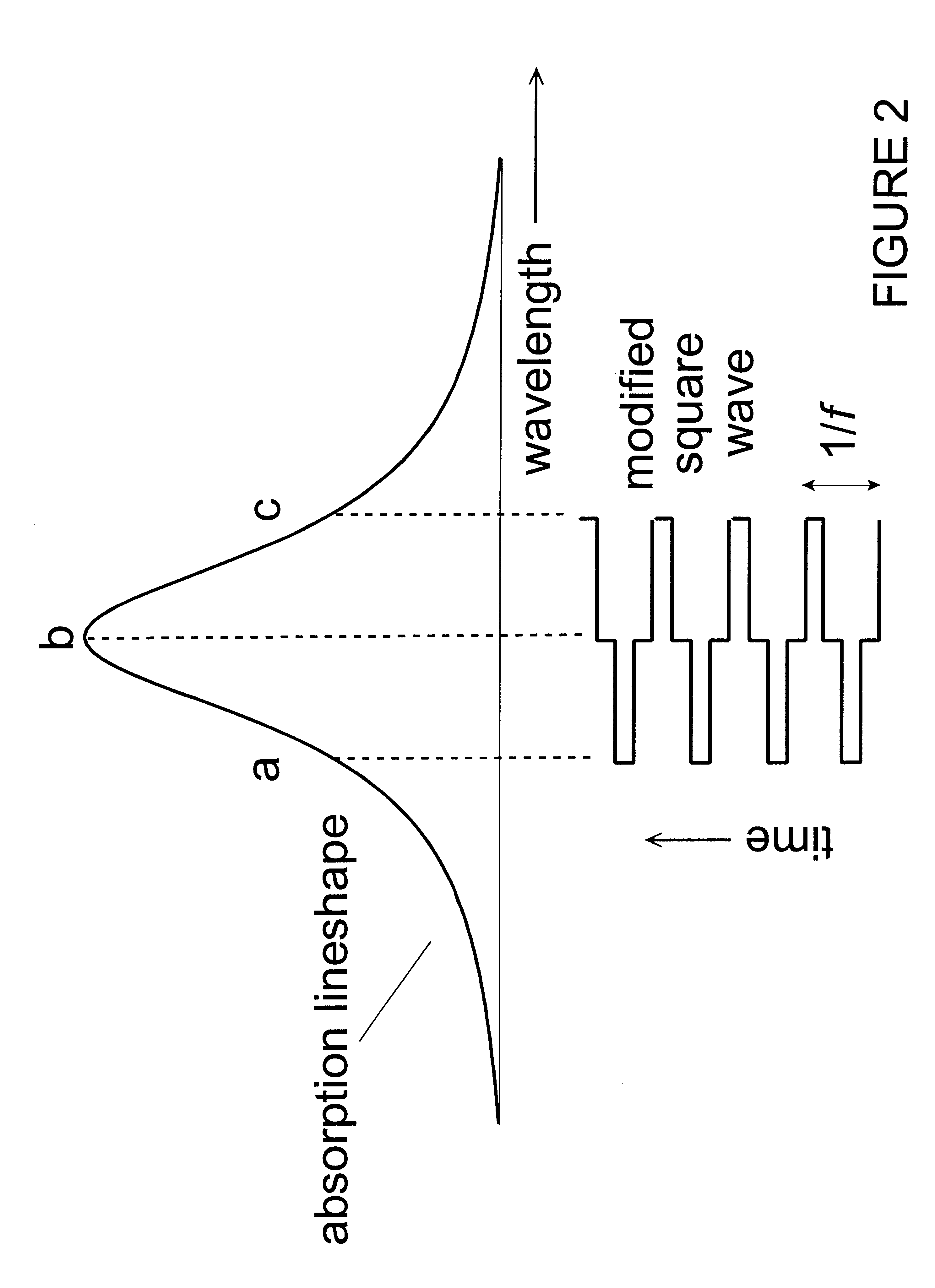Wavelength modulated photoacoustic spectrometer
a photoacoustic spectrometer and wavelength modulation technology, applied in the direction of instruments, color/spectral property measurements, measurement devices, etc., can solve the problems of limiting absorbance sensitivities, limiting product yield, and tracing impurities in semiconductor process gases among the most significant limits to product yield
- Summary
- Abstract
- Description
- Claims
- Application Information
AI Technical Summary
Problems solved by technology
Method used
Image
Examples
embodiment 10
A first system embodiment 10 is shown schematically in FIG. 4. The wavelength of a diode laser 30 is modulated 48 at frequency f by adding 40 a MSQ component to the laser drive current. The MSQ frequency is defined in FIG. 2 as the inverse of the waveform period. Light from the laser passes through a cell 32 that is equipped with a microphone 34, then through a reference cell 36, shown in phantom, containing an amount of the target species, and finally impinges on a photodiode detector 38. The microphone signal is demodulated 44 at frequency 2f 50 while the average laser wavelength is constrained 46 to coincide with the center of the absorption line of interest. The photoacoustic 2f signal is a maximum at this wavelength and the magnitude of the signal can be used for continuous monitoring of the concentration of the target species. It will be appreciated that demodulation 44 at other harmonics may be used for obtaining WM-PAS signal 42. Additionally, multiple harmonics may be obtai...
first embodiment
The average laser wavelength is constrained to the center of the absorption line using the photodiode to monitor the wavelength modulated absorption signal due to the target gas within a reference optical path. This wavelength control method, called line-locking, is well known, A. D. White, "Frequency Stabilization of Gas Lasers," IEEE Journal of Quantum Electronics QE-1, 349-357 (1965), and is particularly well-suited to the present invention because the wavelength modulation used in the present invention for improved photoacoustic detection can also be used, without modification, to implement line-locking. In the first embodiment, the output from the photodiode detector 38 is demodulated 46 at frequency 3f 52 to produce a signal that is nominally zero when the average laser wavelength is coincident with the center of the absorption line and varies linearly with small displacements of the wavelength away from line center. This 3f signal is used as part of a feedback loop to control...
second embodiment
the system 20 of the invention, shown schematically in FIG. 7, allows acquisition of wavelength modulated photoacoustic spectra. The average laser wavelength is stepped 56 across the target species absorption feature and the demodulated microphone signal is recorded by a data acquisition system 54 at each wavelength step. The wavelength stepping rate is slow compared with the modulation frequency, preferably allowing at least three periods of the modulation frequency per step. This embodiment is useful when background acoustic noise at the demodulation frequency may interfere with the photoacoustic measurement or when information is required from more than one absorption feature. In this embodiment, the simple MSQ waveform is sufficient for wavelength modulation. This embodiment is also useful for detection of multiple trace gaseous species.
PUM
| Property | Measurement | Unit |
|---|---|---|
| wavelength modulated photoacoustic spectrometry | aaaaa | aaaaa |
| area | aaaaa | aaaaa |
| wavelength | aaaaa | aaaaa |
Abstract
Description
Claims
Application Information
 Login to View More
Login to View More - R&D
- Intellectual Property
- Life Sciences
- Materials
- Tech Scout
- Unparalleled Data Quality
- Higher Quality Content
- 60% Fewer Hallucinations
Browse by: Latest US Patents, China's latest patents, Technical Efficacy Thesaurus, Application Domain, Technology Topic, Popular Technical Reports.
© 2025 PatSnap. All rights reserved.Legal|Privacy policy|Modern Slavery Act Transparency Statement|Sitemap|About US| Contact US: help@patsnap.com



